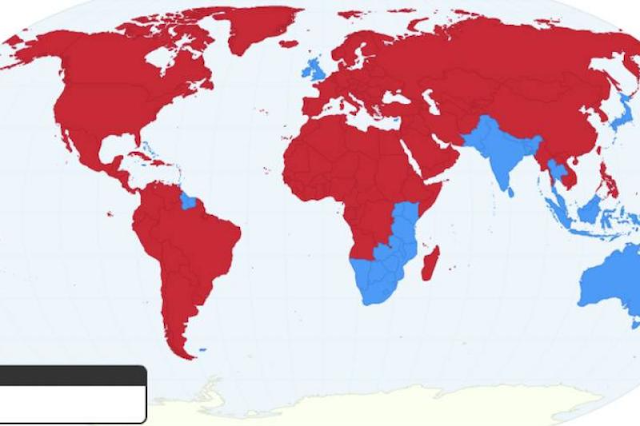There are many technological standards and cultural practices involve immense lock-in due to investments in infrastructure that once in place are very resistant to further standardization. The same is true of cultural practices with high inertia and lock-in such as legal systems, political systems, marriage systems, sports popularity, religion and language.
In most of the world, this largely tracks historically patterns of European colonialism, because the standard determining infrastructure was put in place during the colonial era, but marriage systems, religion and language (other than a national elite lingua franca) usually predate the European colonial era. But other legal differences are relatively recent and reflect recent global legislative trends.
Standard electrical outlet types:
Scholars of comparative law and economists promoting the legal origins theory usually subdivide civil law into four distinct groups:* French civil law: in France, the Benelux countries, Italy, Romania, Spain and former colonies of those countries;* German civil law: in Germany, Austria, Russia, Switzerland, Estonia, Latvia, Bosnia and Herzegovina, Croatia, Kosovo*, North Macedonia, Montenegro, Slovenia, Serbia, Greece, Portugal and its former colonies, Turkey, and East Asian countries including Japan, South Korea, and Taiwan (Republic of China);* Scandinavian civil law: in Denmark, Norway, and Sweden. As historically integrated into the Scandinavian cultural sphere, Finland and Iceland also inherited the system.* Law of the People's Republic of China: a mixture of civil law and socialist law in use in the People's Republic of China.However, some of these legal systems are often and more correctly said to be of hybrid nature:* Napoleonic to Germanistic influence (Italian civil law). The Italian civil code of 1942 replaced the original one of 1865, introducing germanistic elements due to the geopolitical alliances of the time. The Italian approach has been imitated by other countries including Portugal (1966), the Netherlands (1992), Lithuania (2000), Brazil (2002) and Argentina (2014). Most of them have innovations introduced by the Italian legislation, including the unification of the civil and commercial codes.* Germanistic to Napoleonic influence (Swiss civil law). The Swiss civil code is considered mainly influenced by the German civil code and partly influenced by the French civil code. The civil code of the Republic of Turkey is a slightly modified version of the Swiss code, adopted in 1926 during Mustafa Kemal Atatürk's presidency as part of the government's progressive reforms and secularization.
Cousin marriage:
Legal status of polygamy:
Age of majority:














No comments:
Post a Comment